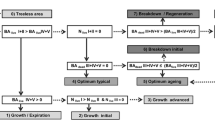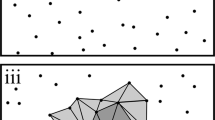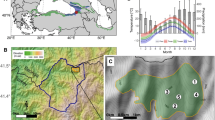Abstract
In the analysis of old-growth forest dynamics, the continuous process of tree aging and forest structural change is split up into several distinct forest development stages. The criteria for distinguishing the stages vary among the different approaches. In most of them, vertical canopy heterogeneity is only coarsely addressed and horizontal forest structure is quantified at spatial scales far exceeding the size of conventional forest inventory plots. In order to describe and analyze the complex mosaic structure of temperate old-growth forests with objective and quantitative measures in the context of forest inventories, we propose the Development Stage Index I DS . It employs two easily measured stand structural parameters (stem density and basal area) for quantifying the abundance of trees in three conventionally recognized tree diameter classes (premature < 40 cm; mature 40–70 cm; and over-mature ≥ 70 cm) in plots of 500 m2 size, systematically distributed in the forest. This allows quantifying the spatial extension of the Initial, Optimum and Terminal stages of forest development at plot, stand and landscape levels. Based on thorough stand structural analyses in three virgin beech (Fagus sylvatica) forests in Slovakia, we demonstrate that I DS is a promising tool for (1) quantifying the proportion of the three stages on different scales, (2) visualizing the complex mixing of stages, and (3) analyzing dynamic changes in old-growth forest structure. We conclude that the Development Stage Index has the potential to improve the empirical foundation of forest dynamics research and to allow this discipline to proceed to more rigorous hypothesis testing.



Similar content being viewed by others
References
Alessandrini A, Biondi F, Di Filippo A, Ziaco E, Piovesan G (2011) Tree size distribution at increasing spatial scales converges to the rotated sigmoid curve in two old-growth beech stands of the Italian Apennines. For Ecol Manag 262:1950–1962
Assmann E (1961) Waldertragskunde. BLV Verlagsgesellschaft, München
Bauhus J, Puettmann K, Messier C (2009) Silviculture for old-growth attributes. For Ecol Manag 258:525–537
Begehold H, Rzanny M, Flade M (2015) Forest development phases as an integrating tool to describe preferences of breeding birds in lowland beech forests. J Ornithol 156:19–29
Bohn U, Neuhäusl R, Gollub R, Hettwer C, Neuhäuslova Z, Schlüter H, Weber H (2003) Karte der natürlichen Vegetation Europas. Teil 1: Erläuterungstext. Landwirtschaftsverlag, Münster
Bottero A, Garbarino M, Dukić V, Govedar Z, Lingua E, Nagel TA, Motta R (2011) Gap-phase dynamics in the old-growth forest of Lom, Bosnia and Herzegovina. Silva Fenn 45(5):875–887
Christensen M, Emborg J, Nielsen AB (2007) The forest cycle of Suserup Skov—revisited and revised. Ecol Bull 52:33–42
Commarmot B, Bachofen H, Bundziak Y, Bürgi A, Ramp B, Shparyk Y, Sukhariuk D, Viter R, Zingg A (2005) Structures of virgin and managed beech forests in Uholka (Ukraine) and Sihlwald (Switzerland): a comparative study. For Snow Landsc Res 79:45–56
Commarmot B, Brändli UB, Hamor F, Lavnyy V (2013) Inventory of the largest virgin beech forest of Europe. A Swiss-Ukrainian scientific adventure. Birmensdorf, Swiss Federal Research Institute WSL; Lviv, Ukrainian National Forestry University, Rakhiv, Carpathian Biosphere Reserve
Drößler L, Lüpke B (2005) Canopy gaps in two virgin beech forest reserves in Slovakia. J For Sci 51:446–457
Drößler L, Meyer P (2006) Waldentwicklungsphasen in zwei Buchen-Urwaldreservaten in der Slowakei. Forstarchiv 77:155–161
Drößler L, Feldmann E, Glatthorn J, Annighöfer P, Kucbel S, Tabaku V (2016) What happens after the gap?—Size distributions of patches with homogeneously sized trees in natural and managed beech forests in Europe. Open J For 6:177–190
Emborg J, Christensen M, Heilmann-Clausen J (2000) The structural dynamics of Suserop Skov, a near natural temperate deciduous forest in Denmark. For Ecol Manag 126:173–179
Franklin JF, Spies TA, Van Pelt R, Carey AB, Thornburgh DA, Berg DR, Lindenmayer DB, Harmon ME, Keeton WS, Shaw DC, Bible K, Chen J (2002) Disturbances and structural development of natural forest ecosystems with silvicultural implications, using Douglas-fir forests as an example. For Ecol Manag 155:399–423
Goff FG, West D (1975) Canopy-understory interaction effects on forest population structure. For Sci 21:98–108
Grassi G, Minotta G, Giannini R, Bagnaresi U (2003) The structural dynamics of managed uneven-aged conifer stands in the Italian eastern Alps. For Ecol Manag 185:225–237
Hobi ML, Ginzler C, Commarmot B, Bugmann H (2015) Gap pattern of the largest primeval beech forest of Europe revealed by remote-sensing. Ecosphere 6:1–15
Holeksa J, Saniga M, Szwagrzyk J, Czerniak M, Staszyńska K, Kapusta P (2009) A giant tree stand in the West Carpathians—an exception or a relic formerly widespread mountain European forests? For Ecol Manag 257:1577–1585
Holzwarth F, Kahl A, Bauhus J, Wirth C (2013) Many ways to die—partitioning tree mortality dynamics in a near-natural mixed deciduous forest. J Ecol 101:220–230
Hunter ML Jr (1990) Wildlife, forests and forestry: principles of managing forests for biological diversity. Prentice-Hall, Englewood Cliffs
Jaworski A, Podlaski R (2007) Structure and dynamics of selected stands of primeval character in the Pieniny National Park. Dendrobiology 58:25–42
Kenderes K, Král K, Vrška T, Standovar T (2009) Natural gap dynamics in a Central European mixed beech-spruce-fir old-growth forest. Ecoscience 16(1):39–47
Korpel Š (1995) Die Urwälder der Westkarpaten. Gustav Fischer Verlag, Stuttgart
Král K, Janík D, Vrška T, Adam D, Hort L, Unar P, Šamonil P (2010a) Local variability of stand structural features in beech dominated natural forests of Central Europe: implications for sampling. For Ecol Manag 260:2196–2203
Král K, Vrška T, Hort L, Adam D, Šamonil P (2010b) Developmental phases in a temperate natural spruce-fir-beech forest: determination by a supervised classification method. Eur J For Res 129:339–351
Král K, Valtera M, Janík D, Šamonil P, Vrška T (2014) Spatial variability of general stand characteristics in central European beech-dominated natural stands—effects of scale. For Ecol Manag 328:353–364
Král K, Shue J, Vrška T, Gonzalez-Akre EB, Parker GG, McShea WJ, McMahon SM (2016) Fine-scale patch mosaic of developmental stages in Northeast American secondary temperate forests: the European perspective. Eur J For Res 135:981–996
Kucbel S, Jaloviar P, Saniga M, Vencurik J, Klimaš V (2010) Canopy gaps in an old-growth fir-beech forest remnant of Western Carpathians. Eur J For Res 129:249–259
Kucbel S, Saniga M, Jaloviar P, Vencurik J (2012) Stand structure and temporal variability in old-growth beech-dominated forests of the northwestern Carpathians: a 40-years perspective. For Ecol Manag 264:125–133
Leibundgut H (1982) Europäische Urwälder der Bergstufe. Paul Haupt, Bern
Leibundgut H (1993) Europäische Urwälder—Wegweiser zur naturnahen Waldwirtschaft. Paul Haupt, Bern
Lombardi F, Cherubini P, Lasserre B, Tognetti R, Marchetti M (2008) Tree rings used to assess time since death of deadwood of different decay classes in beech and silver fir forests in central Apennines (Molise, Italy). Can J For Res 38:821–833
Lombardi F, Marchetti M, Corona P, Merlini P, Chirici G, Tognetti R, Burrascano S, Alivernini A, Puletti N (2015) Quantifying the effect of sampling plot size on the estimation of structural indicators in old-growth forest stands. For Ecol Manag 346:89–97
Meyer P (1999) Bestimmung der Waldentwicklungsphasen und der Texturdiversität in Naturwäldern. Allg Forst-u J-Ztg 170:203–211
Meyer P, Ackermann J, Balcar P, Boddenberg J, Detsch R, Förster B, Fuchs H, Hoffmann B, Keitel W, Kölbel M, Köthke C, Koss H, Unkrig J, Weber J, Willig J (2001) Untersuchungen der Waldstruktur und ihrer Dynamik in Naturwaldreservaten. Arbeitskreis Naturwälder. Bund-Länder-Arbeitsgemeinschaft Forsteinrichtung. IHW-Verlag, Eching
Müller KM (1929) Aufbau, Wuchs und Verjüngung der südosteuropäischen Urwälder. Schaper, Hannover
Müller J, Bütler R (2010) A review of habitat thresholds for dead wood: a baseline for management recommendations in European forests. Eur J For Res 129:981–992
Müller-Using S, Bartsch N (2009) Decay dynamic of coarse and fine woody debris of (Fagus sylvatica L.) forest in Central Germany. Eur J For Res 128:287–296
Nagel TA, Svoboda M (2008) Gap disturbance regime in an old-growth Fagus–Abies forest in the Dinaric Mountains, Bosnia-Herzegovina. Can J For Res 38:2728–2737
Nagel TA, Svoboda M, Kobal M (2014) Disturbance, life history traits, and dynamics in an old-growth forest landscape of southeastern Europe. Ecol Appl 24(4):663–679
Neumann M (1979) Bestandesstruktur und Entwicklungsdynamik im Urwald Rothwald/NÖ und im Urwald Čorkova Uvala/Kroatien. PhD thesis, Univ. f. Bodenkultur, Wien
Oliver CD, Larson BC (1996) Forest stand dynamics. Wiley, New York
Paluch JG (2007) The spatial pattern of a natural European beech (Fagus sylvatica L.)—silver fir (Abies alba Mill.) forest: a patch mosaic perspective. For Ecol Manag 253:161–170
Peck JE, Commarmot B, Hobi ML, Zenner EK (2015) Should reference conditions be drawn from a single 10 ha plot? Assessing representativeness in a 10,000 ha old-growth European beech forest. Restor Ecol 23:927–935
Peterken GF (1996) Natural woodland ecology and conservation in northern temperate regions. Cambridge University Press, Cambridge
Peters R (1997) Beech forests. Geobotany 24. Springer, Berlin
Petráš R, Pajtík J (1991) Sústava Česko-slovenských objemových tabuliek drevín. Lesnícky Časopis 37:49–56
Pretzsch H (2009) Forest dynamics, growth and yield. Springer, Berlin
Přívětivý T, Janík D, Unar P, Adam D, Král K, Vrška T (2016) How do environmental conditions affect the deadwood decomposition of European beech (Fagus sylvatica L.)? For Ecol Manag 381:177–187
Remmert H (1991) The mosaic-cycle concept of ecosystems—an overview. In: Remmert H (ed) The mosaic-cycle concept of ecosystems. Springer, Berlin, pp 1–21
Röhrig E, Bartsch N, Lüpke B (2006) Waldbau auf ökologischer Grundlage. Ulmer, Stuttgart
Schuck A, Meyer P, Menke N, Lier M, Lindner M (2004) Forest biodiversity indicator: deadwood—a proposed approach towards operationalising the MCPFE indicator. In: Marchetti M (ed) Monitoring and indicators of forest biodiversity in Europe—from ideas to operationality. European Forest Institute, EFI PROC. 51, pp 49–77
Spies TA, Franklin JF (1996) The diversity and maintenance of old-growth forests. In: Szaro RC, Johnson DW (eds) Biodiversity in managed landscapes: theory and practice. Oxford Universisty Press, New York, pp 296–314
Tabaku V (2000) Struktur von Buchen-Urwäldern in Albanien im Vergleich mit deutschen Buchen-Naturwaldreservaten und-Wirtschaftswäldern. PhD thesis, Cuvillier Verlag, Göttingen
Tabaku V, Meyer P (1999) Lückenmuster albanischer und mitteleuropäischer Buchenwälder unterschiedlicher Nutzungsintensität. Forstarchiv 70:87–97
Trotsiuk V, Hobi ML, Commarmot B (2012) Age structure and disturbance dynamics of the relic virgin beech forest Uholka (Ukrainian Carpathians). For Ecol Manag 265:181–190
Watt AS (1947) Pattern and process in the plant community. J Ecol 35:1–22
Westphal C, Tremer N, Oheimb G, Hansen J, Gadow K, Härdtle W (2006) Is the reverse J-shaped diameter distribution universally applicable in European virgin beech forests? For Ecol Manag 223:75–83
Winter S, Brambach F (2011) Determination of a common forest life cycle assessment method for biodiversity evaluation. For Ecol Manag 262:2120–2132
Zeibig A, Diaci J, Wagner S (2005) Gap disturbance patterns of a Fagus sylvatica virgin forest remnant in the mountain vegetation belt of Slovenia. For Snow Landsc Res 79:69–80
Zenner EK, Peck JE, Hobi ML, Commarmot B (2014) The dynamics of structure across scale in a primaeval European beech stand. Forestry 88:180–189
Zenner EK, Peck JE, Hobi ML, Commarmot B (2016) Validation of a classification protocol: meeting the prospect requirement and ensuring distinctiveness when assigning forest development phases. Appl Veg Sci 19:541–552
Acknowledgements
The support by the Stemmler Foundation is gratefully acknowledged. We are also grateful to the Poloniny National Park authority, the local forest administrations and the Ministry of Defence of the Slovak Republic for the permits to conduct the study and for technical support during the fieldwork. For organizational and technical support we also like to thank Viliam Pichler and his working group at the Technical University of Zvolen. Many thanks for assistance in the field to Matthias Steckel. We thank two anonymous reviewers for highly useful comments and suggestions on the manuscript.
Funding
This study was supported by the Stemmler Foundation, a member of the Stifterverband für die Deutsche Wissenschaft, Essen, Germany (Grant Number T206/23493/2012).
Author information
Authors and Affiliations
Corresponding author
Ethics declarations
Conflict of interest
The authors declare that they have no conflict of interest.
Additional information
Communicated by Claus Bässler.
Electronic supplementary material
Below is the link to the electronic supplementary material.
Rights and permissions
About this article
Cite this article
Feldmann, E., Glatthorn, J., Hauck, M. et al. A novel empirical approach for determining the extension of forest development stages in temperate old-growth forests. Eur J Forest Res 137, 321–335 (2018). https://doi.org/10.1007/s10342-018-1105-4
Received:
Revised:
Accepted:
Published:
Issue Date:
DOI: https://doi.org/10.1007/s10342-018-1105-4




